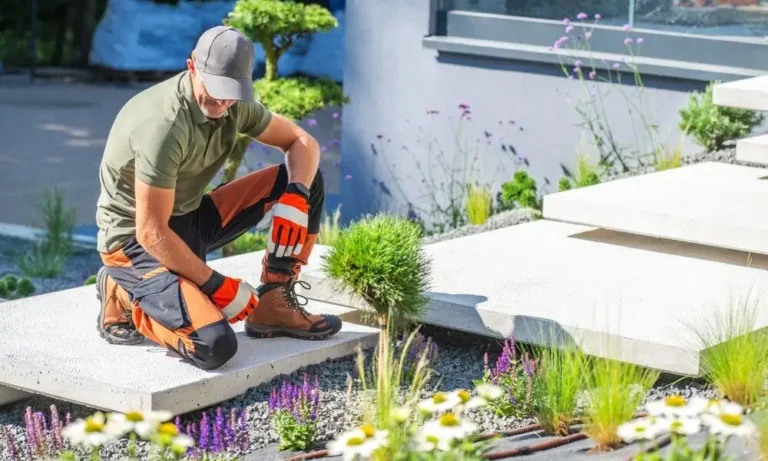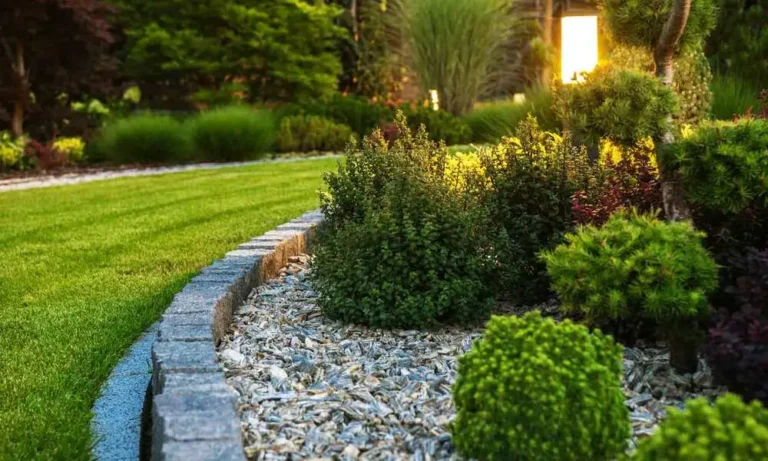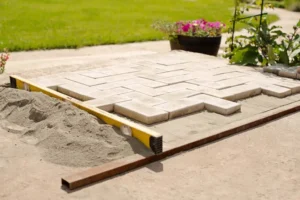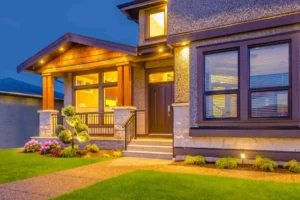What is landscaping? The practice of creating, altering, and maintaining outdoor areas to make them more aesthetically pleasing, useful, and ecologically friendly is known as landscaping. To define landscaping, it includes planting trees, shrubs, flowers, adding decorative elements, and shaping the land. It enhances the appearance and usability of both residential and commercial properties. In homes, landscaping boosts curb appeal and provides a relaxing space. In business settings, it creates a welcoming environment and can improve property value. This article will explore whats landscaping, its types, benefits, and key tips for creating beautiful outdoor areas.
Understanding What is Landscaping?

Landscaping is the art and science of modifying the visible features of an outdoor area—such as a yard, garden, or commercial property—to make it more attractive, functional, and sustainable. It involves designing, planning, and implementing both natural and man-made elements into an outdoor space.
Definition of Landscaping
The definition of landscaping is the process of arranging and modifying land areas to enhance their aesthetic appeal and usability. This includes the integration of plants, terrain shaping, water features, lighting, fences, pathways, and other elements.
Hardscaping vs. Softscaping
Landscaping typically involves two key components:
- Hardscaping: This includes built features including patios, sidewalks, retaining walls, decks, roads, and other non-living landscape components. These are typically made of stone, concrete, wood, or metal and serve structural or decorative purposes.
- Softscaping: This includes the living, organic elements like grass, flowers, shrubs, trees, and soil. Softscaping adds color, texture, and life to the landscape and changes more frequently with seasons and growth.
Both hardscaping and softscaping work together to create a balanced and visually appealing outdoor environment.
Landscaping vs. Gardening
While landscaping and gardening are closely related, they are not the same:
- Landscaping is broader and involves both design and construction elements. It includes hardscaping, softscaping, drainage systems, and often requires professional planning.
- Gardening is more focused on the cultivation and care of plants, such as planting flowers, vegetables, or maintaining lawns and flower beds. It is often considered a subset of landscaping.
Historical Context
Landscaping has roots going back thousands of years. Ancient civilizations like the Egyptians, Persians, and Chinese developed intricate gardens and structured outdoor spaces, reflecting cultural, religious, and aesthetic values. The concept evolved through Renaissance Europe and continues today with a blend of ecological awareness and artistic design.
You can also read about landscape installation in Bay area.
Benefits of Landscaping
Understanding whats landscaping is goes beyond just making your yard look nice. The definition of landscaping involves designing and modifying outdoor spaces to enhance their appearance, functionality, and environmental impact. A well-designed landscape offers a wide range of benefits that extend to the environment, property value, health, and everyday comfort.
Environmental Benefits
- Erosion Control: Proper landscaping stabilizes the soil, especially on slopes or uneven terrain, preventing runoff and soil loss.
- Improved Air Quality: Plants absorb carbon dioxide and release oxygen. Trees and shrubs also filter pollutants from the air.
- Biodiversity Support: Native plants and diverse landscaping attract pollinators like bees and butterflies, as well as birds and small wildlife, supporting a healthy ecosystem.
Aesthetic & Property Value
- Boosts Curb Appeal: A thoughtfully landscaped yard creates a welcoming first impression, making homes more visually appealing.
- Increases Home Value: Studies show that attractive landscaping can increase property value by up to 15%. Buyers are often willing to pay more for a home with a professionally designed outdoor space.
Health & Well-being
- Mental Relaxation: Being in a well-landscaped environment reduces stress, anxiety, and promotes a sense of calm.
- Encourages Outdoor Activity: Landscaped yards make outdoor spaces more enjoyable, motivating people to spend more time outside for exercise, play, or socializing.
Functional Benefits
- Noise Reduction: Trees, shrubs, and fences can act as natural sound barriers, reducing street and neighborhood noise.
- Shade & Energy Efficiency: Strategically placed trees and structures can provide shade, lowering indoor temperatures and reducing energy costs.
- Privacy: Landscaping elements like hedges, trellises, or fences can offer privacy without the need for solid walls.
Types of Landscaping
To understand the different types, it’s good to first know what’s landscaping. The definition of landscaping is changing and shaping outdoor spaces by adding things like plants, trees, walkways, and other features. There are many types of landscaping, each with its own purpose and style.
Residential Landscaping
This is landscaping done around homes. It includes front yards, backyards, gardens, and spaces for relaxing or playing. Homeowners usually choose designs that are easy to take care of and look nice year-round.
Commercial Landscaping
This type is for businesses, office buildings, hotels, or shopping centers. Keeping the area tidy and hospitable for guests and clients is the aim.
Hardscape Elements
These are the non-living parts of landscaping. They include:
- Patios – Outdoor areas for sitting or eating
- Walkways – Paths made from stone, brick, or concrete
- Retaining Walls – Walls that hold soil in place, often used in sloped areas
Softscape Elements
These are the living parts of landscaping, like:
- Plants – Flowers, shrubs, and bushes
- Trees – For shade, beauty, or privacy
- Grass – Covers open ground and gives a fresh, green look
Xeriscaping (Drought-Resistant Landscaping)
Water-efficient plants are used in this kind of landscaping. It’s great for dry areas and helps save water. Cactus, succulents, rocks, and gravel are common in xeriscaping.
Sustainable Landscaping
This focuses on using natural resources wisely. It includes collecting rainwater, using native plants, reducing waste, and planting trees to cool the area and reduce energy use.
Theme-Based Landscaping
This type follows a certain style or look. Some examples are:
- Zen Gardens – Simple, peaceful spaces with rocks, sand, and a few plants
- Tropical – Lush plants, palm trees, and bright flowers
- Modern Minimalist – Clean lines, simple designs, and fewer plants
Ideas & Options for Landscaping

If you’re wondering what is a landscaping, it’s all about designing outdoor spaces in a way that makes them more useful and pleasant to look at. Whether you’re working on your front yard or backyard, there are plenty of creative and practical options to choose from—no matter your budget, time, or style.
Front Yard vs. Backyard Ideas
- Front Yard: This is the first thing people see, so it’s great to keep it neat and welcoming. Ideas include simple flower beds, a stone pathway, a small lawn, or some low shrubs around the edges.
- Backyard: This area is more private, so you can do more with it. Think of seating areas, a vegetable garden, a play area for kids, or even a fire pit for evenings with friends.
Low-Maintenance Landscaping Options
If you don’t want to spend a lot of time on upkeep, try these:
- Use native plants that grow well in your area
- Add mulch to stop weeds and hold in water
- Choose slow-growing shrubs and evergreen plants
- Use gravel or decorative rocks instead of grass in some spots
Budget-Friendly Landscaping Ideas
You don’t need a lot of money to make your yard look nice:
- Start small—work on one area at a time
- Use second-hand planters or DIY garden beds
- Grow plants from seeds instead of buying full-grown ones
- Use ground cover plants instead of laying sod
Seasonal Landscaping Ideas
Different seasons can offer different styles:
- Spring: Plant flowers like tulips and daffodils
- Summer: Add shade with umbrellas or tall plants
- Fall: Use colorful leaves, pumpkins, and hardy plants
- Winter: Try evergreens, winter lights, and simple decorations
Water Features, Lighting & Pathways
To add extra beauty and function to your yard:
- Water Features: Small fountains, birdbaths, or mini ponds can add sound and movement
- Lighting: Solar lights along walkways or string lights in trees create a warm feel
- Pathways: Use stepping stones, gravel, or bricks to connect spaces and make it easy to walk around
Where to Get Ideas for Landscaping
- Home Improvement Magazines & Books: These classic resources are filled with innovative designs, expert advice, and the latest trends. They can help you spark ideas and make informed decisions for your landscaping projects.
- Pinterest, Instagram, and Social Media Platforms: Social media is an endless treasure trove of creative landscaping concepts. Platforms like Pinterest and Instagram allow you to explore thousands of photos, videos, and mood boards to inspire your outdoor space transformation.
- Consulting with Landscape Designers: There’s no better way to bring your ideas to fruition than by working with a professional. At Lakota Design Group, our expert designers work closely with you to create personalized landscaping solutions that fit your style, needs, and budget.
At Lakota Design Group, we pride ourselves on providing exceptional landscaping design services in the Bay Area. Our team is committed to turning your outdoor space into a stunning oasis. Whether you’re looking for a contemporary garden, sustainable landscaping, or a custom outdoor living area, we have the knowledge and expertise to guide you every step of the way.
Final Thoughts
FAQs
Landscaping is the art of designing and creating beautiful, functional outdoor spaces. At Lakota Design Group, we specialize in turning your outdoor dreams into reality, whether you’re looking for a modern, low-maintenance garden or a lush, natural retreat. Our expert designers provide personalized landscaping services to fit your style and needs. Get inspired by the latest trends, and let us help you transform your yard into a stunning outdoor space. Contact us at (408) 826-2888 for any type of query related to landscape designs and services!
Why Is Landscaping Important For My Property?
Landscaping not only improves the visual appeal of your outdoor space but also increases property value, creates functional outdoor living areas, and enhances the overall environment by promoting sustainability.
What Does A Landscaping Designer Do?
A landscaping designer works with clients to create custom outdoor spaces that fit their aesthetic preferences, needs, and the local environment. They design layouts, select plants, and recommend materials for construction and maintenance.
What Are The Different Types Of Landscaping Designs?
Landscaping designs can range from formal, contemporary, and modern styles to more natural, rustic, or sustainable designs. The choice depends on your preferences, available space, and maintenance requirements.
How Can Lakota Design Group Help With My Landscaping Project?
At Lakota Design Group, we offer expert landscaping design services, including personalized consultations, custom plans, and expert installation. Our team is dedicated to transforming your outdoor space into something beautiful and functional.





